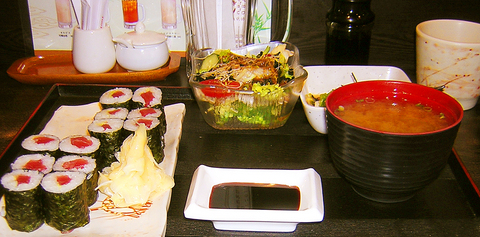Looking to explore Japanese food but don’t think you can settle on just one dish? Plan on eating with friends who have a hard time agreeing on what to order? Want to drink lots of alcohol and enjoy a good meal at the same time? This restaurant solves these dilemmas in one fell swoop.
Yabu Soba serves izakaya ryori (居酒屋料理), or pub-style food. Think of the rathskeller you visit for dinner, except this one serves Japanese dishes and you order a bunch of small but substantial courses to share with a group. There are tables in the back, with bamboo blinds and pictures of sumo wrestlers for decoration. In the evening things get lively and you can still eat at the bar, although this one offers a view of sake bottles and sushi preparation instead of whiskey and beer taps.
On a recent visit a party of seven shared seven delicious dishes and consumed several one-liter bottles of Kirin beer. The result was a satisfying meal and the tab came out at NT$450 per person. Impressively, staff offered to alter the portions of each dish to suit the size of our group.

PHOTO: RON BROWNLOW, TAIPEI TIMES
Memorable courses included the roast potato slices topped with mentaiko, or marinated roe, (NT$160, 烤馬鈴薯明太子), California rolls (NT$160, 加州酪梨捲) and beef tataki (NT$360, 日式生煎牛排), slices of raw steak that have been lightly seared on the outside and are to be dipped in a ponzu sauce. The sauce is what makes this dish. Stir in sliced ginger and scallions thoroughly before dipping the thinly sliced beef.
Staff also recommended the kimchee beef (NT$190, 韓國泡菜牛肉), chicken wings with mentaiko inside (NT$190, 烤雞翅包明太子), and the restaurant’s trademark soba noodles (NT$150, 日式蕎麥冷麵). There’s also a decent selection of vegetable and tofu dishes, such as fried tofu (NT$70, 炸豆腐) and spinach with egg (NT$130, 菠菜蛋); tell staff if you’re a vegetarian before ordering. This being an izakaya, there’s a drinks menu that features around a dozen brightly colored cocktails.
Yabu Soba moved from its old location on Linshen North Road four years ago. It’s now on Nanjing East Road next to the Emperor Hotel and three blocks east of the Zhongshan MRT station.
During lunchtime things are much more subdued and Yabu Soba looks more like a run-of-the-mill Taipei Japanese eatery, albeit one with an extensive and eclectic menu. Lunch prices run from NT$110 for soup noodles to NT$250 or more for a set meal with soup, salad and entree.

In the March 9 edition of the Taipei Times a piece by Ninon Godefroy ran with the headine “The quiet, gentle rhythm of Taiwan.” It started with the line “Taiwan is a small, humble place. There is no Eiffel Tower, no pyramids — no singular attraction that draws the world’s attention.” I laughed out loud at that. This was out of no disrespect for the author or the piece, which made some interesting analogies and good points about how both Din Tai Fung’s and Taiwan Semiconductor Manufacturing Co’s (TSMC, 台積電) meticulous attention to detail and quality are not quite up to

April 21 to April 27 Hsieh Er’s (謝娥) political fortunes were rising fast after she got out of jail and joined the Chinese Nationalist Party (KMT) in December 1945. Not only did she hold key positions in various committees, she was elected the only woman on the Taipei City Council and headed to Nanjing in 1946 as the sole Taiwanese female representative to the National Constituent Assembly. With the support of first lady Soong May-ling (宋美齡), she started the Taipei Women’s Association and Taiwan Provincial Women’s Association, where she

Chinese Nationalist Party (KMT) Chairman Eric Chu (朱立倫) hatched a bold plan to charge forward and seize the initiative when he held a protest in front of the Taipei City Prosecutors’ Office. Though risky, because illegal, its success would help tackle at least six problems facing both himself and the KMT. What he did not see coming was Taipei Mayor Chiang Wan-an (將萬安) tripping him up out of the gate. In spite of Chu being the most consequential and successful KMT chairman since the early 2010s — arguably saving the party from financial ruin and restoring its electoral viability —

It is one of the more remarkable facts of Taiwan history that it was never occupied or claimed by any of the numerous kingdoms of southern China — Han or otherwise — that lay just across the water from it. None of their brilliant ministers ever discovered that Taiwan was a “core interest” of the state whose annexation was “inevitable.” As Paul Kua notes in an excellent monograph laying out how the Portuguese gave Taiwan the name “Formosa,” the first Europeans to express an interest in occupying Taiwan were the Spanish. Tonio Andrade in his seminal work, How Taiwan Became Chinese,